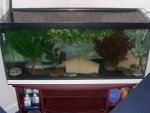Vicster1979
New member
- Joined
- Apr 13, 2008
- Messages
- 31
- Reaction score
- 0
- Points
- 0
- Location
- Barnstaple, Devon
- Country
- United Kingdom
We got our Axolotls on Saturday from someone who kept a lot of them outdoors in a pond.
We did our readings on our water, and made sure it was the same temperature as the pond water we collected them in. All was fine, they settled in well. They were both really active, and eating well.
Now the temperature is stuck at 20 degrees, we have been using freezer packs to try and cool it down with no joy, and yesterday on doing another reading found that the water had really high ammonia levels. We did a 30% water change yesterday, and all seemed fine again. Got rid of some of the rocks at the bottom to try and prevent waste building up. We make sure any uneaten food is removed straight away, but today it is sky high again.
Jules is now in the process of another water change. This time a 50% one to see if this helps.
Could it be anything to do with the pond weeds we have in the tank. The guy gave them to us from his pond, and Ren & Stumpy love hiding, and generally hanging out in them. Could this be the problem at all? They are starting to yellow a bit now, but overall look ok. The man said to weigh them down and they would take.
We are at a loss as to what to do. We thought water changes only needed to be done every couple of weeks, and then only 30%. Surely this can't be right. We don't want to stress the guys out anymore, they are not so active now, and spend more time hiding. Are still eating though.
Any suggestions would be greatly appreciated.
We did our readings on our water, and made sure it was the same temperature as the pond water we collected them in. All was fine, they settled in well. They were both really active, and eating well.
Now the temperature is stuck at 20 degrees, we have been using freezer packs to try and cool it down with no joy, and yesterday on doing another reading found that the water had really high ammonia levels. We did a 30% water change yesterday, and all seemed fine again. Got rid of some of the rocks at the bottom to try and prevent waste building up. We make sure any uneaten food is removed straight away, but today it is sky high again.
Jules is now in the process of another water change. This time a 50% one to see if this helps.
Could it be anything to do with the pond weeds we have in the tank. The guy gave them to us from his pond, and Ren & Stumpy love hiding, and generally hanging out in them. Could this be the problem at all? They are starting to yellow a bit now, but overall look ok. The man said to weigh them down and they would take.
We are at a loss as to what to do. We thought water changes only needed to be done every couple of weeks, and then only 30%. Surely this can't be right. We don't want to stress the guys out anymore, they are not so active now, and spend more time hiding. Are still eating though.
Any suggestions would be greatly appreciated.


